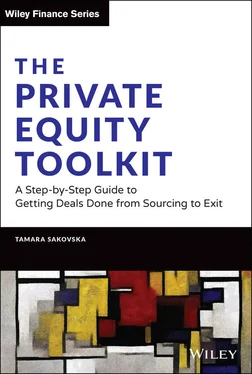I typically follow-up with an email too, the point of which is not so much to thank them for their time (I do that too, in case you're wondering), but to provide them with three or four bullet points of information about the deals my team is targeting in the medium term. Effectively, this is an opportunity to broadcast the well-thought-out message you crafted in a previous step to a motivated audience. This summary can also double up as a useful reference for your contacts later, either to remind them what was discussed or even to forward it around to their colleagues and industry contacts. This approach will require an upfront investment of your own time, so it makes sense to contain it to a finite number of parties. I have found that this effort really helps to activate your firm's most valuable connections, leverage others to advocate for your mandate and create a virtuous cycle of new deal ideas, all of which are likely to have far more relevance than a random inbound transaction landing on your desk.
4. Add new relevant connections to your network

They say that success is not about what you know, but whom you know. But maybe it's actually about whom you do not know—at least not yet. Building a search network entails adding new connections that are relevant to your goal. According to Bruner (2004), networks reduce the cost of deal search and afford economies of scale and scope in your search efforts. Furthermore, networks provide a mechanism that helps you spread your message faster, as knowledge inevitably travels from one node to another in a well-functioning network. The nodes in our case are people who may have access to valuable information and potential deals. Metcalfe's Law, 2 which states that the value of a network is proportional to the number of working nodes in it, applies well in this instance. Based on this rationale, it makes sense for deal professionals to increase the number of working nodes by enhancing the diversity and breadth of their networks. Bruner (2004) asserts that professional connectivity is a form of social capital that should be cultivated as carefully as talent, financial capital, or physical property.
It sounds very convincing. But what are the concrete steps? You can start with these:
Analyze your firm's existing connections. You have now had an opportunity to assess your firm's network and develop a list of the top 10% most valuable connections. What can you say about the rest of the network? Among the remaining 90%, are there parties who perhaps do not work closely with your fund at present, but potentially could provide you with access to markets that are relevant for your deal search? It makes sense to get closer to these intermediaries and educate them about your current investment focus.
Identify who you would like to meet and begin outreach. Think about the gaps in your firm's network. What are the areas where you should aim to enhance your connectivity? Who can help you find relevant new opportunistic investments, given your current investment focus? Create a list of people and companies that you would like to meet. Determine how many degrees of separation are between you and work on gaining proximity to them. If you are looking for specific ideas for your outreach, it might be helpful to refer to my suggestions in Step 4 of the Thematic Deal Sourcing ICEBERG Roadmap™.
Activate your “weak ties.” Chances are your best friend is unlikely to be able to introduce you to a good investment opportunity. That's because both of you probably operate in very similar environments and have an overlapping group of acquaintances, so you already know and experience a lot of what your friend does. However, more distant acquaintances are likely to operate in a completely different environment, have access to a totally new opportunity set and, therefore, present a valuable source of information.It is especially worth mentioning the value of “weak ties” within your educational network, i.e. the people who went to the same university as you. Fuchs et al. (2017) conducted research investigating the role of educational networks in private equity by analyzing a data set of over 3,000 buyout investments that were made in the United States and Western Europe between 1984 and 2010. The conclusion is very interesting: not only do educational ties exist in 15% of buyout deals in this data set, but they also seem to improve the odds of a fund winning a deal by 79%. 3 Educational networks appear to serve as a productive source of deal origination and may provide easier deal access and a degree of exclusivity for funds sharing an educational connection with a target company.
Join new and relevant professional interest groups. Given that you have a clear idea of what types of deals you are looking for, consider joining communities that will enrich and strengthen your ability to find them. Aim to broaden your social contacts by becoming a member of relevant trade associations, curated industry networks and online platforms, where you can connect with relevant people or get more insights into your target market. Use every opportunity to broadcast a clear message to your network about what deals you are looking for and then rely on Metcalfe's Law to work its magic.

We see brands everywhere. Does a private equity fund need active brand management? If the goal is to be top of mind, then most definitely yes. If your fund has a superb investment track record, your firm will be top of mind without any marketing efforts on your part. LPs will be lining up to make an investment in your latest fund, sellers of businesses will approach your fund directly, and there will be no shortage of qualified job applicants. People want to associate themselves with top firms in order to maximize the likelihood of their own success.
What if your fund's track record is broadly comparable to that of many other firms? Or, what if you work for a new fund? Then, a serious marketing endeavor might be in order. After all, your brand needs to be recognized and respected by those people most likely to help you with opportunistic deal search. Brand sets expectations, and it is important to differentiate and strengthen your company's external image. How do you do that? My guess is that it will be hard to execute in-house without hiring a brand agency with experience in financial services.
It's difficult to find research on trends in private equity branding. The only brand study I could find that is specifically related to the private equity industry is a survey published in 2017 by a financial marketing firm, BackBay Communications. It has useful insights about brand management, rebranding activities and effective marketing communication in the private equity industry. This study inspired me to look around and think about how the private equity firms that I know well stay top of mind in their markets. Here is a list of my observations:
Corporate website. Private equity funds use every opportunity to communicate their history, investment approach and differentiated value-add on their website. It becomes increasingly more common to include fairly rich and highly specific content with insights about particular sectors, interviews with investment professionals and investment case studies about closed transactions.
Social media. Even the most conservative funds with a global footprint, such as KKR and Carlyle, use social media to promote their brand through news updates, podcasts, blogs and video recordings. 4 It is easy to keep up to date with the latest investments, exits and fund closings.
Читать дальше














